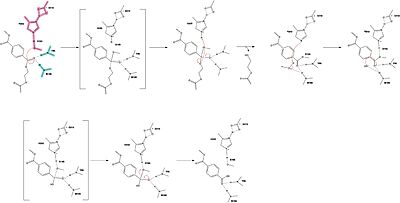User:Anjali Rabindran/Sandbox 1
From Proteopedia
| Line 13: | Line 13: | ||
<scene name='10/1075190/F243i/1'>F234I</scene> | <scene name='10/1075190/F243i/1'>F234I</scene> | ||
| - | == Function == | ||
| - | == | + | == Results == |
| + | '''Table 1.''' Specific activity and rate of wild-type, WCCG, and ICCG mutants. Initial rate was measured by the calculated rate of reaction by NaOH consumption. Specific activity was measured via pf-PET-depolymerization assay.<ref name="Tournier et. al. 2020">PMID:32269349</ref> | ||
| + | |||
| + | |||
| + | <table> { | ||
| + | border-spacing: 10px; | ||
| + | } | ||
| + | <tr> | ||
| + | <th>Enzyme</th> | ||
| + | <th>Initial rate (g<sub>hydrolyzed PET</sub>•L<sup>-1</sup>•h<sup>-1</sup>)</th> | ||
| + | <th>Specific activity (mg<sub>TAeq</sub>h<sup>-1</sup>•mg<sub>enzyme</sub><sup>-1</sup>) ± SD </th> | ||
| + | </tr> | ||
| + | <tr> | ||
| + | <td>Wild-Type</td> | ||
| + | <td>25.7</td> | ||
| + | <td>81.9 ± 5.6 </td> | ||
| + | </tr> | ||
| + | <tr> | ||
| + | <td>WCCG</td> | ||
| + | <td>30.3</td> | ||
| + | <td>75.9 ± 5.9</td> | ||
| + | </tr> | ||
| + | <tr> | ||
| + | <td>ICCG</td> | ||
| + | <td>31.0</td> | ||
| + | <td>82.0 ± 3.9</td> | ||
| + | </tr> | ||
| + | </table> | ||
| - | == Relevance == | ||
== Mechanism == | == Mechanism == | ||
[[Image:PET_hydrolase_Mechanism.jpeg|400 px|left|thumb|Figure Legend]] | [[Image:PET_hydrolase_Mechanism.jpeg|400 px|left|thumb|Figure Legend]] | ||
| + | |||
| - | </StructureSection> | ||
| - | == References == | ||
| + | == References == | ||
<references/> | <references/> | ||
Revision as of 14:23, 8 April 2025
Contents |
PET Hydrolase!!!!!😁😁😁😊😊😊😊😊
Structure
|
Researchers have been investigating various mutations of PET hydrolase to enhance is catalytic ability. One group of researchers, Tournier et. al., have made mutations in the PET hydrolase active site. They identified the key residues involved in the catalytic mechanism by using a model of the onto the enzyme. The site, mainly a hydrophobic pocket, contained 11 residues targeted for mutagenesis. From this, they identified that the majority of enzymes specific activity went down, however, the mutation of the F243 to either isoleucine or tryptophan actually increased specific activity.
Results
Table 1. Specific activity and rate of wild-type, WCCG, and ICCG mutants. Initial rate was measured by the calculated rate of reaction by NaOH consumption. Specific activity was measured via pf-PET-depolymerization assay.[1]
| Enzyme | Initial rate (ghydrolyzed PET•L-1•h-1) | Specific activity (mgTAeqh-1•mgenzyme-1) ± SD |
|---|---|---|
| Wild-Type | 25.7 | 81.9 ± 5.6 |
| WCCG | 30.3 | 75.9 ± 5.9 |
| ICCG | 31.0 | 82.0 ± 3.9 |
Mechanism
References
- ↑ Tournier V, Topham CM, Gilles A, David B, Folgoas C, Moya-Leclair E, Kamionka E, Desrousseaux ML, Texier H, Gavalda S, Cot M, Guemard E, Dalibey M, Nomme J, Cioci G, Barbe S, Chateau M, Andre I, Duquesne S, Marty A. An engineered PET depolymerase to break down and recycle plastic bottles. Nature. 2020 Apr;580(7802):216-219. doi: 10.1038/s41586-020-2149-4. Epub 2020 Apr, 8. PMID:32269349 doi:http://dx.doi.org/10.1038/s41586-020-2149-4

